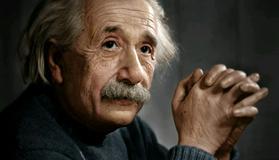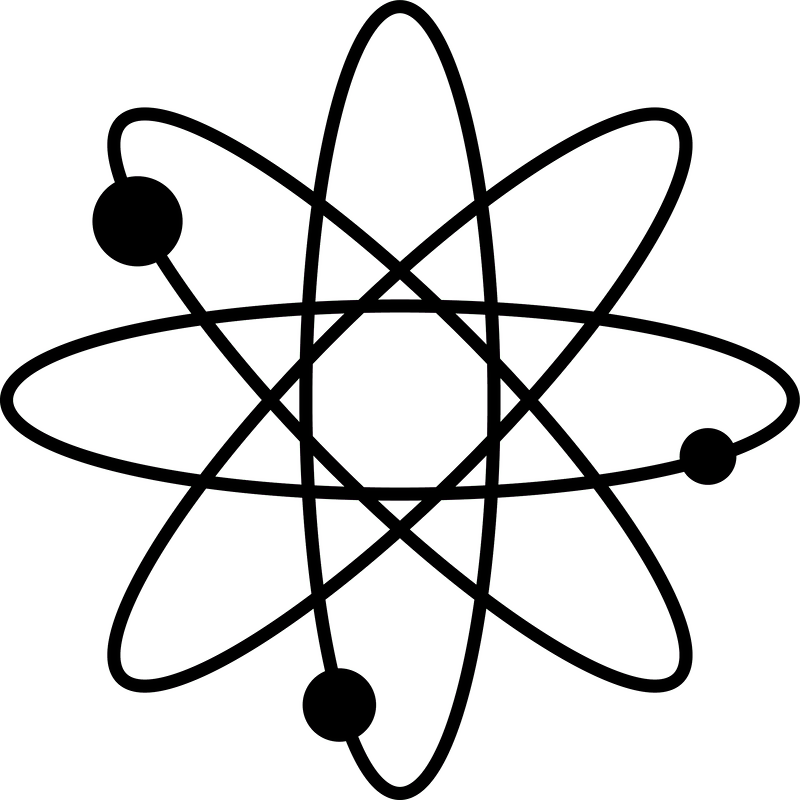PhysicsPrimer
物理入门
Time Dilation Experiment
时间膨胀实验
At this point, our discussion of timedilation might seem awfully abstract or unphysical. Clocks moving with thespeed of light? How could you even read such a clock? Plus, wouldn't they getsqueezed and all deformed?
在这一点上,我们的时间膨胀的讨论可能会显得太抽象的或非物理的。时钟以光的速度运动?你怎么能读到这样的钟?另外,他们不会被挤压和变形吗?
Let's move away from the thoughtexperiments and look at an actual experiment that confirmed the time dilation.The experiment has been first carried out in 1940 and repeated ever since,including by undergraduates. This is a greatly simplified exposition:
让我们从思想实验中移开,看一个证实时间膨胀的实际实验。该实验于1940首次进行,此后一直重复,包括本科生在内。这是一个大大简化的论述:
Muons are elementary particles (verysimilar to the electrons) that are naturally generated by cosmic rays hittingthe upper atmosphere. Muons are unstable, and after a very short period of timethey decay into some other particles. The "decay time" is a propertyof the muons and can be measured experimentally. To simplify the problem wewill consider the "decay time" to represent the time after which amuon decays into something else. (In reality, not all muons decay at the sametime and we can only know the probability with which a muon will decay. Whilethis will slightly affect the numerical end result, the reasoning about timedilation is not affected.)
μ介子的基本粒子(电子的非常相似),是由宇宙射线撞击大气自然生成。介子是不稳定的,和很短的时间内衰变为其它粒子后他们。“衰减”是其他财产可以测量实验。为了简化这个问题,我们将考虑“衰变时间”来表示μ子衰变为其他物质的时间。(在现实中,并不是所有的μ介子衰变的同时,我们只能知道概率,μ介子衰变。虽然这会稍微影响数值最终结果,但不影响时间膨胀的推理。)

The muon decay time is  and when the muons are formed in the upper atmosphere they traveldown towards the Earth with a speed close to the speed of light, v=0.99c. Ifyou were to simply estimate the distance they would travel before decaying youwould get:
and when the muons are formed in the upper atmosphere they traveldown towards the Earth with a speed close to the speed of light, v=0.99c. Ifyou were to simply estimate the distance they would travel before decaying youwould get:
介子衰变时间τ=2.2⋅10−6s和当μ介子在大气上层他们旅行到地球一个速度接近光速的速度形成,V = 0.99c。如果你仅仅距离估计他们会在衰变之前你会旅行:
D=τ⋅c=653m
However, muons are created at altitudes ofaround 10000m (10km) and they can be detected at sea level! This cannot beexplained by a classical physicist, unless he questions your measurements. Sowhat happened?
然而,μ介子在10000m海拔(10km)他们可以在海平面的检测!这不能用经典物理学家来解释,除非他质疑你的测量。发生了什么事?
The muon "decay time" of τ ismeasured in the rest frame of the particle. You generate a muon in the lab andyou keep it fixed in front of you until it decays. You could think about themuon as possessing an internal clock that tells it when to decay. Because themuon is at rest in the lab, its internal clock is at sync with the clock of theobserver. Now, when the muons are formed in the upper atmosphere they move downtowards the Earth at a speed of v=0.99c. For the rest observer at ground level,the internal clock of the muons has slowed down: 1s on the internal clock ofthe moving muon is γ seconds on theobserver's clock. So for the rest observer the moving muon will take a time τ′>τ to decay:
介子衰变时间”τ是粒子的静止坐标系的测量。你在实验室里产生一个μ介子,然后你把它固定在你面前,直到它腐烂为止。你可以认为μ介子有一个内部时钟,告诉它什么时候衰变。由于μ介子在实验室中处于静止状态,它的内部时钟与观测者的时钟同步。现在,当μ介子以速度v = 0.99c上层大气中他们将朝地球形成。在地面休息观察,对介子内部时钟已经放缓:1的移动介子内部时钟在观测者的时钟γ秒。所以对于其他观察员运动μ子将时间τ′>τ腐烂:
τ′=γτ
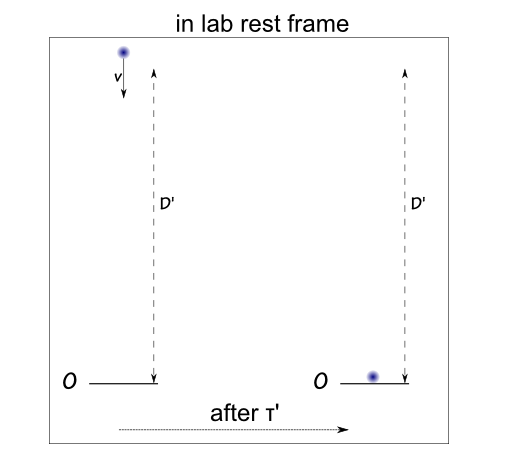
For the rest observer the muons will travelover a distance
对于其他观察员的介子将旅行的距离
D′=τ′⋅c=γτ⋅
Numerically, the decay time for the movingmuon is:
数值上,运动μ子的衰减时间是:

Using this, we find D′=4630m. The real distance is actually larger, because the muon decaytime is an average of all the possible decay times, and after the time τ only half of the muons have decayed. But the point is made - timedilation is real and it affects not only light-clocks but any physical quantitythat is related to a time interval.
利用这一点,我们发现D′= 4630m。真正的距离其实更大,因为μ介子的衰变时间是所有可能的衰变时间的平均值,并τ只有一半的介子腐朽后的时间。但关键在于时间膨胀是真实的,它不仅影响光钟,而且影响到与时间间隔有关的任何物理量。
A Paradox?
一个悖论?
There is another cool side to the muonexperiment. So far, we have only talked about what the observer at rest in thelab would see. In this simplified example a muon is created at 4600m and itreaches the observer at sea level and it decays. But what would the muon see?The muon sees the Earth moving towards him with a velocity v=0.99 for a time τ.So for the muon the Earth is moving for a distance D=τ⋅c. Though the muon and the observer might not agree about the time,they must agree about the physical events -- and the muon reaching the observeris such an event that must take place in both reference systems. But if theEarth moves only the distance D=τ⋅cit never reaches the muon who is at a distance D′=γτ⋅c (as it wasestablished above). So in one system the muon and the observer meet, but in theother system they don't!!! What happened?
μ子实验还有一个很酷的方面。到目前为止,我们只讨论了在实验室休息的观察者会看到什么。在这个简单的例子是创建在4600mμ介子,达到观察员在海平面和它的衰变。但是μ子会看到什么呢?介子看到地球朝着他以速度v = 0.99一时间τ。所以对于μ地球移动一个距离d =τ⋅虽然介子和观察者可能不同意的时候,他们必须同意关于物理事件和介子到达观察者是这样的一个事件必须发生在参考系统。但如果地球只能移动的距离d =τ⋅C它从未达到μ子是谁在距离D′=γτ⋅C(因为它是建立在这个上)。所以在一个系统中μ子和观测者相遇,但在另一个系统中他们不这样!!!怎么搞的?
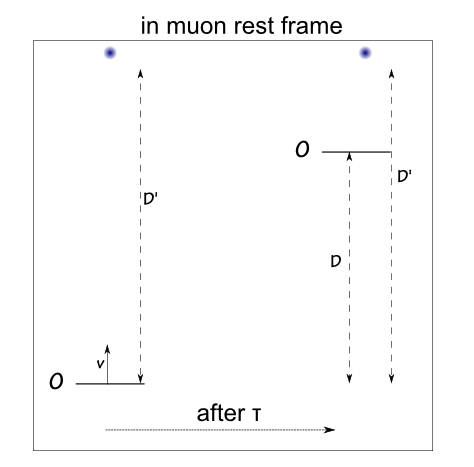
Whenever you think things make sense,special relativity hits you with another paradox.
每当你认为事情有意义时,狭义相对论就会给你带来另一个悖论。
The distance D′=γτ⋅c=4600m betweenthe observer and the birth place of the muon is measured in the rest frame ofthe observer! For the moving muon, this whole length is moving with a speed vso the length will contract with a factor 1/γ to give
距离D′=γτ⋅C = 4600m之间的观察者和出生地的μ子测量在静止的观察者!对于运动的μ子,整个长度以v速度移动,所以长度将与一个因子1/γ相吻合。
D′/γ=τ⋅c=D
For the muon, the Earth travels for ashorter time τ over a shorter distance D. Special relativity is saved again!(We will talk more about length contractions in the future lectures.)
为μ,地球旅游的时间较短,在较短的距离τD.狭义相对论又节省!(我们将在以后的讲座中进一步讨论长度收缩)。
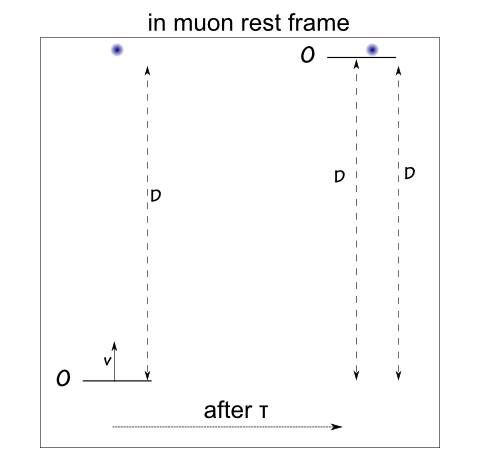
Time Dilation Experiment
时间膨胀实验
At this point, our discussion of timedilation might seem awfully abstract or unphysical. Clocks moving with thespeed of light? How could you even read such a clock? Plus, wouldn't they getsqueezed and all deformed?
在这一点上,我们的时间膨胀的讨论可能会显得太抽象的或非物理的。钟以光的速度运动?你怎么能读到这样的钟?另外,他们不会被挤压和变形吗?
Let's move away from the thoughtexperiments and look at an actual experiment that confirmed the time dilation.The experiment has been first carried out in 1940 and repeated ever since,including by undergraduates. This is a greatly simplified exposition:
让我们从思想实验中移开,看一个证实时间膨胀的实际实验。该实验于1940首次进行,此后一直重复,包括本科生在内。这是一个大大简化的论述:
Muons are elementary particles (verysimilar to the electrons) that are naturally generated by cosmic rays hittingthe upper atmosphere. Munos are unstable, and after a very short period of timethey decay into some other particles. The "decay time" is a property ofthe muons and can be measured experimentally. To simplify the problem we willconsider the "decay time" to represent the time after which a muondecays into something else. (In reality, not all muons decay at the same timeand we can only know the probability with which a muon will decay. While thiswill slightly affect the numerical end result, the reasoning about timedilation is not affected.)
μ介子的基本粒子(电子的非常相似),是由宇宙射线撞击大气自然生成。穆纽斯是不稳定的,和很短的时间内衰变为其它粒子后他们。“衰减”是其他财产可以测量实验。为了简化这个问题,我们将考虑“衰变时间”来表示μ子衰变为其他物质的时间。(在现实中,并不是所有的μ介子衰变的同时,我们只能知道概率,μ介子衰变。虽然这会稍微影响数值最终结果,但不影响时间膨胀的推理。)
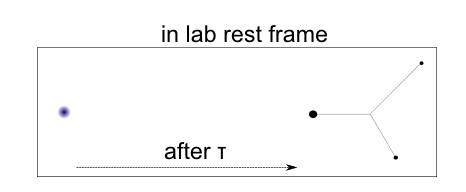
The muon decay time is τ=2.2⋅10−6s and when the muons are formed inthe upper atmosphere they travel down towards the Earth with a speed close tothe speed of light, v=0.99c. If you were to simply estimate the distance theywould travel before decaying you would get:
μ介子衰变时间τ= 2.2⋅10−6S和当μ介子在大气上层他们旅行到地球一个速度接近光速的速度形成,V = 0.99c。如果你仅仅距离估计他们会在衰变之前你会旅行:
D=τ⋅c=653m
However, muons are created at altitudes ofaround 10000m (10km) and they can be detected at sea level! This cannot beexplained by a classical physicist, unless he questions your measurements. Sowhat happened?
然而,μ介子在10000m海拔创造(10km)他们可以在海平面的检测!这不能用经典物理学家来解释,除非他质疑你的测量。发生了什么事?
The muon "decay time" of τ ismeasured in the rest frame of the particle. You generate a muon in the lab andyou keep it fixed in front of you until it decays. You could think about themuon as possessing an internal clock that tells it when to decay. Because themuon is at rest in the lab, its internal clock is at sync with the clock of theobserver. Now, when the muons are formed in the upper atmosphere they move downtowards the Earth at a speed of v=0.99c. For the rest observer at ground level,the internal clock of the muons has slowed down: 1s on the internal clock ofthe moving muon is γ seconds on theobserver's clock. So for the rest observer the moving muon will take a time τ′>τ to decay:
μ介子衰变时间”τ是粒子的静止坐标系的测量。你在实验室里产生一个μ介子,然后你把它固定在你面前,直到它腐烂为止。你可以认为μ介子有一个内部时钟,告诉它什么时候衰变。由于μ介子在实验室中处于静止状态,它的内部时钟与观测者的时钟同步。现在,当μ介子以速度v = 0.99c上层大气中他们将朝地球形成。在地面休息观察,对介子内部时钟已经放缓:1的移动介子内部时钟在观测者的时钟γ秒。所以对于其他观察员运动μ子将时间τ′>τ衰退:
τ′=γτ
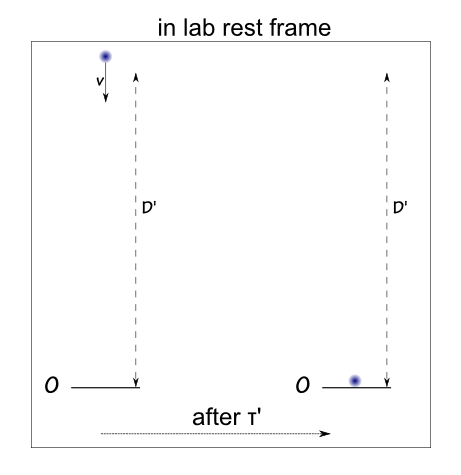
For the rest observer the muons will travelover a distance
对于其他观察员的介子将旅行的距离
D′=τ′⋅c=γτ⋅
Numerically, the decay time for the movingmuon is:
数值上,运动μ子的衰减时间是:

Using this, we find D′=4630m. The real distance is actually larger, because the muon decaytime is an average of all the possible decay times, and after the time τ only half of the muons have decayed. But the point is made - timedilation is real and it affects not only light-clocks but any physical quantitythat is related to a time interval.
利用这一点,我们发现D′= 4630m。真正的距离其实更大,因为μ介子的衰变时间是所有可能的衰变时间的平均值,并τ只有一半的介子衰退后的时间。但关键在于时间膨胀是真实的,它不仅影响光钟,而且影响到与时间间隔有关的任何物理量。
